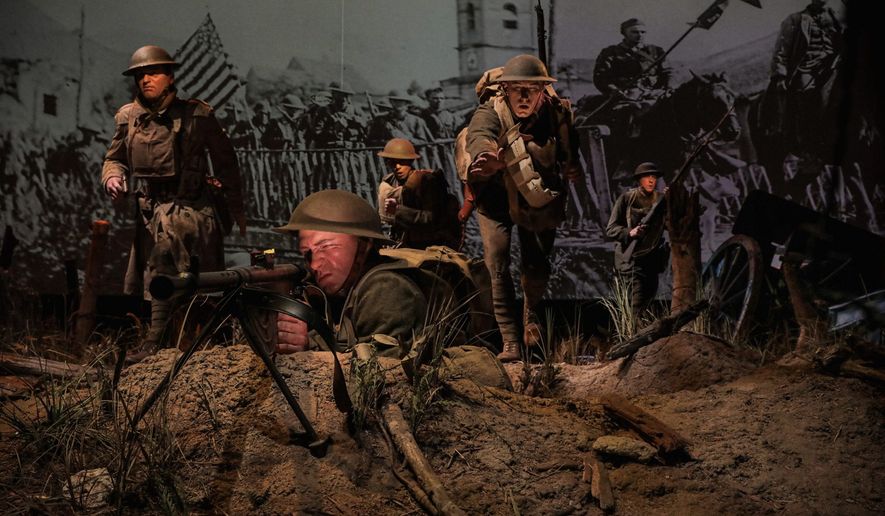A mysterious silver-colored building adjacent to Northern Virginia’s Fort Belvoir may look like an spy agency or a Silicon Valley startup, but it’s actually there to tell a story almost 250 years in the making.
After grand opening delays brought about by the COVID-19 pandemic, the roughly $400 million National Museum of the United States Army is finally set to open its doors to the public on Veterans Day this Wednesday.
The 185,000-square-foot museum chronicles the history of the nation’s oldest military service from its roots as a provincial militia in the early 1600s to combat operations in Afghanistan and Iraq and deployments around the world.
“The museum is stunning, and it is an honor to present this history in a way that shows the connection between the American soldier, the U.S. Army and the nation,” said Tammy Call, the museum’s director.
The museum traces the Army’s history chronologically and through particular themes such as “Preserving the Nation,” the Civil War and the “Global War,” which portrays the Army’s role in the Allied victory of World War II. Scattered throughout the museum are more than 1,500 artifacts, documents and personal stories from soldiers.
Pass through the “Founding the Nation” exhibit, and a visitor will come across several items from the Revolutionary War period, including a King Howitzer, a small cannon that was popular in the 18th century, and a powder horn used by Sgt. Levi Gassett, who served at Dorchester Heights during the British siege of Boston in 1775.
For many of the items in the museum’s collection, “this is the first time they are being displayed,” Ms. Call said. “It is important to preserve these items and have them available.”
Forming the centerpieces of the galleries are figures in Army uniforms from various eras. These figures, portrayed in combat, are modeled on real soldiers with razor stubble, crow’s feet or teenage acne scars.
“These are humanistic cast figures. We sent the soldiers to the studios that provided them,” Ms. Call said. “That’s what makes them so lifelike.”
The museum is a joint effort between the Army and the Army Historical Foundation, which constructed the building using private funds. The Army, which owns and operates the museum, provided the infrastructure, roads and utilities.
“The National Museum of the United States Army is designed to tell the compelling and heroic stories of our people and take visitors on an exciting journey,” said Gen. James C. McConville, the Army chief of staff. “The Army is people. They are our greatest strength and our most important weapon system.”
Opening in a pandemic
Museum officials said they are taking a variety of steps to help ensure the health and safety of visitors during the COVID-19 pandemic. Free timed-entry tickets are required to manage visitor capacity. Each visitor is given a handheld stylus to use the computer touch screens throughout the exhibition.
“We have worked hard to ensure the safety of our staff and visitors,” Ms. Call said.
The artifacts on display are critical to familiarize visitors, some who may have no connection to the Army, with the soldiers who fought and sometimes gave their lives.
Included in the D-Day exhibit is an M1 Garand rifle carried by Pvt. Martin Teahan, an 82nd Airborne Division paratrooper who was killed during the Normandy invasion. A French army officer discovered the lost rifle several decades after World War II and returned it to Teahan’s family.
A pocket Bible carried by Pvt. 1st Class Melvin Nesteby, a prisoner of war and survivor of World War II’s “Bataan death march,” is also part of the collection. Ms. Call said Nesteby’s Bible gives her chills each time she passes it.
“He carried it with him throughout the war. He said that’s what kept him going,” she said. “These artifacts have such personnel connections to the soldier.”
Museum officials said they want visitors to get a sense of what it was like to serve in the ranks throughout the Army’s history. Projected onto a massive 300-degree theater is footage of current Army operations along with dramatic re-creations of some of the most significant battles. A high-tech simulator gives virtual reality experiences in World War II tank battles and historic Army aircraft.
Officials said the museum also confronts some controversial parts of the Army’s history, such as racial segregation, the My Lai massacre in Vietnam and the treatment of detainees in Iraq’s Abu Ghraib prison.
“Those things are openly discussed here,” said Paul Morando, chief of exhibits. “We know these events happen, but they’re not indicative of the Army values. They do not reflect what the Army is all about.”
The museum has established an education department to host presentations and discussions about Army-based research and scholarship, he said.
The Army’s place in the larger American story and its role in the culture are depicted in the “Army and Society” gallery.
“The whole point of the gallery is to address issues like that and the relationship between civilians and the Army,” Mr. Morando said. “We’re not just talking about the history of the Army. We’re also addressing societal issues.”
The displays will eventually rotate to better tell the Army’s story and keep it current. Museum officials said they plan to add items from soldiers who were at the Ain al-Asad base in Iraq’s western Anbar province during a Jan. 8 missile barrage fired in retaliation for a U.S. drone strike that killed Maj. Gen. Qassem Soleimani, Iran’s top military official.
“We want to make sure there’s a personal connection with the soldier,” Mr. Morando said.
—
Corrected from earlier version which misspelled Mr. Morando’s last name.
• Mike Glenn can be reached at mglenn@washingtontimes.com.




Please read our comment policy before commenting.